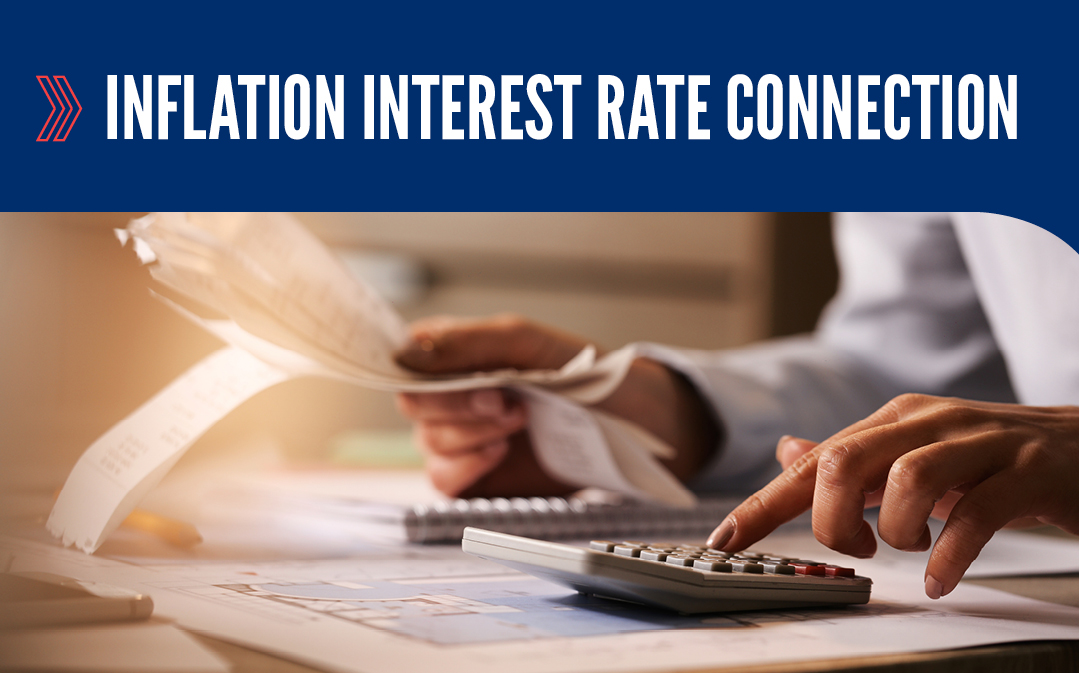We’re all reeling at the price of lettuce and the extra expense at the petrol bowser these days. The news tells us it’s due to inflation. So, what exactly does that mean? What is inflation? What are inflationary pressures? Why is inflation so high right now? Do interest rates rise with inflation? Why does inflation affect interest rates? And how do these affect the skyrocketing cost of living in Australia? Is it all as glum as it seems? In this post, the experts at Capital Properties will answer all these questions and more.
It’s important to acknowledge that the relationship between inflation and interest rates is complex. In a nutshell, it means that when inflation increases faster than expected, interest rates will rise. Interest rate hikes are used as a response from banks to help curb rapid rises in inflation.
But if the intricacies of inflation and interest were that straightforward, we wouldn’t need economists! In reality, there are many nuances to consider in order to understand how inflation and interest rates work.
If you’re in the Sydney area and want to know more about how inflation might affect your home loan, then why not book a free discovery session with Capital Properties today?
We specialise in helping Australian Defence Force members learn about the property investment market. With blog posts like things you should know about buying a house while in the ADF we share tips to help you buy and sell property, and our buyers agent service takes care of all the hard work for you.
On the go? Here’s 30 seconds of take outs:
- We explore the questions everyone’s asking:
- What is inflation?
- What are inflationary pressures?
- Why is inflation so high right now?
- Do interest rates rise with inflation?
- Why does inflation affect interest rates?
- What does it mean for Australians?
- Inflation can be defined as “the increase in the price of household goods and services which is measured as the rate of change of these items over time”.
- The Australian Bureau of Statistics (ABS) calculates inflation quarterly based on the average household’s spend on goods & services known as the Consumer Price Index (CPI).
- There are 2 types of inflation, temporary & persistent. Persistent inflation is either ‘demand-pull’, ‘cost-push’ or ‘built-in’ inflation.
- Inflation is the highest it’s been for 20 years due to the war in Ukraine, low unemployment, increased energy prices & low pandemic interest rates.
- The government raises interest rates to curb inflation.
- Capital Properties can help you explore opportunities in the property investment market in these challenging economic times.
Keep reading >>
What is inflation?
We’ve all heard about inflation. We know it’s increasing. But many people are unsure about what it actually is. So, let’s answer the question on everyone’s lips right now “What is inflation?”.
Given that people have written entire books on the subject, we’re not going to pretend that this is a comprehensive definition, but in essence we define inflation as “the increase in the price of household goods and services which is measured as the rate of change of these items over time”. Simple right?
Here’s a quick formula to calculate inflation for individual items:
(Price year 2 – price year 1)
Price year 1 x100
Let’s look at this brief example to help understand it further:
| Item | 2021 price | 2022 price | Inflation % |
| Bottle of wine | 20 | 22 | 10% |
| Phone case | 10 | 15 | 50% |
So, interpreting inflation for individual items is pretty straightforward. However, when we examine inflation on a national level it becomes a lot more complicated.
In order to measure inflation across the whole Australian economy, every quarter the Australian Bureau of Statistics (ABS) collects prices for thousands of goods and services, and groups them into categories. Then the ABS calculates the price changes of these items over that quarter and works out the inflation rate.
Each item for which inflation is calculated is given a weight derived from the average household spend on each item. And every household’s overall spend is referred to as a ‘basket’. These metrics are known as Consumer Price Index (CPI) weights.
It’s safe to say that governments worldwide track inflation obsessively. But the next question to tackle is why prices are changing all the time? And what actually causes inflation?
Common inflationary pressures
We call the underlying causes of inflation “inflationary pressures”. Inflationary pressures trigger economic adjustment to changes in supply and demand. There are two primary types of inflation, each with its own causes:
Temporary inflation is caused by issues such as supply interruption. A great example is the increased price of petrol due to the war in Ukraine. Economists don’t usually include temporary inflation when performing their calculations.
Persistent inflation is what people usually refer to when speaking of inflation. It is most often precipitated by increased circulating money due to various factors. These causes are commonly broken down into three main categories:
- Demand-pull inflation – when demand for a good or service exceeds production capacity (people can afford things they couldn’t before).
- Cost-push inflation – when production costs increase prices (people producing goods are getting paid more than they were).
- Built-in inflation – a circular type of inflation; as wages increase, so too do prices (the steadiest type of inflation).
Now that we’ve answered the question “what is inflation?” and “what causes inflation?”, let’s examine why inflation is so high in Australia right now.
Why is inflation so high in Australia?
Inflation in Australia is currently at a 20-year high. The causes are numerous and diverse and include:
- The war in Ukraine, which has led to increases in food and energy costs.
- Low unemployment rates – which means that on average, people have more disposable income.
- Increased energy prices on the east coast of Australia (the East Coast Energy Crisis).
- Record low interest rates during the pandemic, again meaning more disposable income for Australians
All of these factors are leading to a multi-factorial increase in inflation not just in Australia, but across the Organisation for Economic Co-operation and Development (OECD).
Now, let’s refer to the last point above, interest rates. We’re often asked, “do interest rates rise with inflation”? Well, low interest rates seem to lead to higher inflation, so let’s explore this relationship a little further.
Relationship between inflation and interest rates
Fast rises in inflation are no good for anyone, and curbing inflation is something that governments take very seriously. A hike in interest rates is one of the government’s first lines of defence to slow inflation.
We know this may sound counter-intuitive and even unfair. Many people will feel stressed that prices are already rising, and then banks raise the amount that must be repaid on top of that. But this strategy is effective and necessary to keep the economy balanced. A rise in interest rates reduces disposable income meaning people can’t spend as much on goods and services. Ostensibly harsh, but efficient.
Why is the cost of living so high in Australia?
When inflation is at a sustainable level, the cost of living generally increases in line with wages, but a rapid increase in inflation leads to an increased cost of living. And in Australia, we’ve seen drastic increases in the price of everyday goods and services such as:
- Groceries
- Coffee
- Petrol
- International travel
But it’s not all doom and gloom. Economies constantly go through cycles, with fluctuations in inflation and interest rates happening all the time. Whilst it may seem bad now, we know from experience that the system will balance out eventually.
If you need help understanding how inflation and interest rates might affect your home loan repayments or if you’re looking to get into the housing market but feel overwhelmed with all that’s happening in the world, contact Capital Properties today. We can help you get the best deal when buying a home.
Book a free Discovery Session to find out more about how we work and what we can do to help you achieve future financial security.






